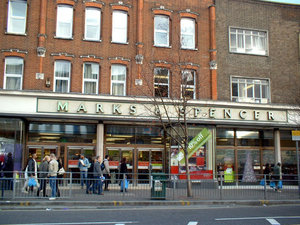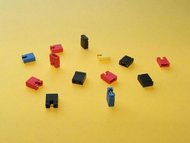Marks & Spencer
|
|
M&S_logo.PNG
Company logo
Marks and Spencer plc (known also as M&S and sometimes colloquially as Marks and Sparks) is a British retailer. It is the largest clothing retailer in the UK by turnover (ASDA claimed first place by volume in 2004), and it is also a multi-billion pound food retailer. Most of its shops sell both of these categories. It also has a third line of business selling homewares such as bedlinen, but this is far smaller than the other two. For much of the 20th century Marks and Spencer was regarded as the leading retailer in the United Kingdom, and an icon of British business. In 1997 it became the first British retailer to make a profit before tax of over £1 billion, but within a couple of years, it plunged into a crisis from which it has not yet fully recovered. It is now less than one quarter of the size of the UK's largest and most profitable retailer Tesco.
M&s.JPG
| Contents |
History
The original firm was a chain of "penny bazaars", founded by Thomas Spencer and a Jewish immigrant, Michael Marks in Leeds. It became a household name thanks to the efforts of Marks' son, Simon Marks, and his friend, Israel Seiff.
Unlike most of its rivals M&S resisted the lure of television advertising when ITV was launched in 1955, preferring to rely on its reputation to draw in customers. It was not until the mid-1990s that the first TV commercials for M&S clothing were broadcast.
Marks and Spencer made their reputation in the 20th century on a policy of only selling British-made goods. They entered into long term relationships with British manufacturers, and sold the goods under the "St Michael" brand, which was used for both clothes and food. The companies put its main emphasis on quality, but for most of its history, it also had a reputation for offering fair value for money. When this reputation began to waver, it encountered serious difficulties.
Marks and Spencer's profits peaked in 1997 and 1998. At the time it was seen as a continuing success story, but with hindsight it is considered that during Sir Richard Greenbury's tenure as head of the company, profit margins were pushed to untenable levels, and the loyalty of its customers was seriously eroded. The rising cost of using British suppliers was also burden, as rival retailers increasingly imported their goods from low-cost countries, but the Marks and Spencer own belated switch to overseas suppliers undermined a core part of its appeal to the public. In addition, as an ageing and famously bureaucratic company, was losing touch with potential younger customers, who were reluctant to shop with it. These factors combined to plunge Marks and Spencer into a sudden slump, which took the company, its shareholders, who included hundreds of thousands of small investors, and nearly all retail analysts and business journalists by surprise. The company's share price fell by more than two thirds, and its profits fell from more than a billion pounds in 1997 and 1998 to £145 million in the year ended 31 March 2001.
Since the late 1990s Marks and Spencer has experienced serious boardroom instability and has made a number of attempts to revive its business, with only partial success. In 2001, with changes in their business focus such as the introduction of the "Per Una" clothing range designed by George Davies, accompanied by a redesign of their underlying business model, profits rose sharply and M&S recovered much of its market share. Other changes to tradition included accepting credit cards and opening their stores on Sunday occasionally.
Marks and Spencer was recently (2004) in the throes of an attempted takeover by Arcadia boss, Philip Green. On July 12 a recovery plan was announced which would involve selling off the financial services business to HSBC, buying control of the Per Una range, closing the Gateshead Lifestore and stopping the expansion of its Simply Food line of stores. Philip Green withdrew his takeover bid after failing to get sufficient backing from shareholders.
The headquarters of M&S was for many years in Baker Street, London; during World War II these offices were used by the Special Operations Executive for secret missions in Occupied Europe. In 2005 the company moved to a new headquarters in Paddington, London.
The St. Michael brand has now been discontinued in favour of Marks & Spencer.
Chairmen
International operations
M&S have expanded to 28 countries around the globe. They are mostly present in former British colonies and Eastern Europe; the attempt to expand into Western Europe and the United States failed due to their high prices and the particularly British vision of the company. The expansion into France was particularly unsuccessful, and eventually they were forced to close all their French stores, though because of the legislation set in place by the French government to protect their labour force, this was a costlier exercise than the Marks and Spencer management anticipated. The first Marks and Spencer store in central Asia was built in Kabul, Afghanistan in the 1960s. The store was later shut down as the mood of the city turned conservative.
Financial performance
Until 1999, Marks & Spencer's financial year ended on 31 March. Since then, the company has changed to reporting for 52 or 53 week periods, on variable dates.
| Year ended | Turnover (£) | Profit before tax (£) | Net profit (£) | Basic eps (p) |
|---|---|---|---|---|
| 2 Apr 2005 | 7,942.3 | 745.3 | 587.0 | 29.1 |
| 3 Apr 2004 | 8,301.5 | 781.6 | 552.3 | 24.2 |
| 29 Mar 2003 | 8,019.1 | 677.5 | 480.5 | 20.7 |
| 30 Mar 2002 | 8,135.4 | 335.9 | 153 | 5.4 |
| 31 Mar 2001 | 8,075.7 | 145.5 | 1.3 | 0.0 |
| 1 Apr 2000 | 8,195.5 | 417.5 | 258.7 | 9.0 |
| 31 Mar 1999 | 8,224.0 | 546.1 | 372.1 | 13.0 |
| 31 Mar 1998 | 8,243.3 | 1,155.0 | 815.9 | 28.6 |
| 31 Mar 1997 | 7,841.9 | 1,102.1 | 746.6 | 26.7 |
| 31 Mar 1996 | 7,233.7 | 965.8 | 652.6 | 23.3 |
Marks and Spencer Finance was sold during the group's 2004-05 financial year and the turnover figure includes turnover from discontinued operations of £232.0 million. There were other exceptional items in the year, principally restructuring costs of £91.4 million. Profit on ordinary activities before tax and exceptional items was £618.5 down 23.2% from £805.0 million the previous year.
External links
- Marks & Spencer Online (http://www.marksandspencer.com/)


